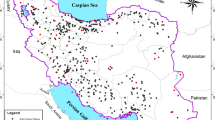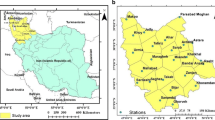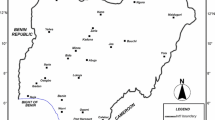Abstract
Monthly precipitation time series of 155 synoptic stations distributed over Iran, covering 1990–2014 time period, were used to identify areas with different precipitation time variability and regimes utilizing S-mode principal component analysis (PCA) and cluster analysis (CA) preceded by T-mode PCA, respectively. Taking into account the maximum loading values of the rotated components, the first approach revealed five sub-regions characterized by different precipitation time variability, while the second method delineated eight sub-regions featured with different precipitation regimes. The sub-regions identified by the two used methods, although partly overlapping, are different considering their areal extent and complement each other as they are useful for different purposes and applications. Northwestern Iran and the Caspian Sea area were found as the two most distinctive Iranian precipitation sub-regions considering both time variability and precipitation regime since they were well captured with relatively identical areas by the two used approaches. However, the areal extents of the other three sub-regions identified by the first approach were not coincident with the coverage of their counterpart sub-regions defined by the second approach. Results suggest that the precipitation sub-region identified by the two methods would not be necessarily the same, as the first method which accounts for the variance of the data grouped stations with similar temporal variability while the second one which considers a fixed climatology defined by the average over the period 1990–2014 clusters stations having a similar march of monthly precipitation.
















Similar content being viewed by others
References
Alexandersson H (1986) A homogeneity test applied to precipitation data. J Climatol 6:661–675
Amante C, Eakins BW (2009) ETOPO1 1 arc-minute global relief model: procedures, data sources and analysis. NOAA Technical Memorandum NESDIS NGDC-24. National Geophysical Data Center, NOAA. doi:10.7289/V5C8276M
Andrade dos Santos JC (2004) Climate variability in Europe and its connection to the tropospheric and stratospheric circulations: a case study for Portugal. Ph.D. dissertation, university of lisboa, Portugal
Buishand TA (1982) Some methods for testing the homogeneity of rainfall records. J Hydrol 58:11–27
Cattel RB (1966) The scree test for the number of factors. Multivar Behav Res 1:245–276
Cerny CA, Kaiser HF (1977) A study of a measure of sampling adequacy for factor-analytic correlation matrices. Multivar Behav Res 12(1):43–47
Chen LJ, Chen DL, Wang HJ, Yan JH (2009) Regionalization of precipitation regimes in China. Atmospheric and Oceanic Science Letters 2(5):301–307
Comrie AC, Glenn EC (1998) Principal components-based regionalization of precipitation regimes across the southwest United States and northern Mexico, with an application to monsoon precipitation variability. Clim Res 10:201–215
Darand M, Mansouri Daneshvar MR (2014) Regionalization of precipitation regimes in Iran using principal component analysis and hierarchical clustering analysis. Environ Process 1:517. doi:10.1007/s40710-014-0039-1
Dezfuli AK, Karamouz M, Araghinejad S (2010) On the relationship of regional meteorological drought with SOI and NAO over southwest Iran. Theor Appl Climatol 100:57–66
Dinpashoh Y, Fakheri-Fard A, Moghaddam M, Jahanbakhsh S, Mirnia M (2004) Selection of variables for the purpose of regionalization of Iran’s precipitation climate using multivariate methods. J Hydrol 297:109–123
Domroes M, Kaviani M, Schaefer D (1998) An analysis of regional and intra-annual precipitation variability over Iran using multivariate statistical methods. Theor Appl Climatol 61:151–159
Drosdowsky W (1993) An analysis of Australian seasonal rainfall anomalies: 1950-1987. I: spatial patterns. Int J Climatol 13:1–30
Fernández Mills G (1995) Principal component analysis of precipitation and rainfall regionalization in Spain. Theor Appl Climatol 50(3):169–183
Ghorbani-Aghdam M, Dinpashoh Y, Mostafaeipour A (2013) Application of factor analysis in defining drought prone areas in Lake Urmia Basin. Nat Hazards 69(1):267–277
Green MC, Flocchini G, Myrup LO (1993) Use of temporal principal components analysis to determine seasonal periods. J Appl Meteorol 32(5):986–995
Huth R (1997) Continental-scale circulation in the UKHI GCM. J Clim 10:1545–1561
Kansakar SR, Hannah DM, Gerrard AJ, Rees G (2004) Spatial pattern in the precipitation regime of Nepal. Int J Climatol 24:1645–1659
Kashani M, Dinpashoh Y (2012) Evaluation of efficiency of different estimation methods for missing climatological data. Stoch Env Res Risk A 26(1):59–71
Lawley DN (1956) Tests for significance for the latent roots of covariance and correlation matrices. Biometrica 43:128–136
Miller JA, Goodrich GB (2007) Regionalization and trends in winter precipitation in the northwestern USA. Clim Res 33:215–227
Modarres R, Sarhadi A (2011) Statistically-based regionalization of rainfall climates of Iran. Glob Planet Chang 75:67–75
North GR, Bell TL, Cahalan RF (1982) Sampling errors in the estimation of empirical orthogonal functions. Mon Wea Rev 110:699–706
Pettitt AN (1979) A non-parametric approach to the change-point detection. Appl Stat 28:126–135
Rao AR, Srinivas VV (2006) Regionalization of watersheds by hybrid-cluster analysis. J Hydrol 318:37–56
Raziei T, Sotoudeh F, (2016) Investigation of the accuracy of the European Center for Medium Range Weather Forecast (ECMWF) in forecasting observed precipitation in different climates of Iran. Journal of earth and space physics (Accepted for publication)
Raziei T, Bordi I, Pereira LS (2008) A precipitation-based regionalization for western Iran and regional drought variability. Hydrol Earth Syst Sci 12:1309–1321
Raziei T, Bordi I, Pereira LS (2011) An application of GPCC and NCEP/NCAR datasets for drought variability analysis in Iran. Water Resour Manag 25:1075–1086
Raziei T, Mofidi A, Santos JA, Bordi I (2012) Spatial patterns and regimes of daily precipitation in Iran in relation to large-scale atmospheric circulation. Int J Climatol 32:1226–1237
Raziei T, Bordi I, Pereira LS (2013) Regional drought modes in Iran using the SPI: the effect of time scale and spatial resolution. Water Resour Manag 27:1661–1674
Richman MB (1986) Rotation of principal components. J Climatol 6:293–335
Richman MB, Lamb PJ (1985) Climatic pattern analysis of three- and seven-day summer rainfall in the central United States: some methodological considerations and a regionalization. J Climate Appl Meteor 24:1325–1343
Richman MB, Lamb PJ (1987) Pattern analysis of growing season precipitation in southern Canada, Atmos. Ocean 25(2):137–158
Rousseeuw PJ (1987) Silhouettes: a graphical aid to the interpretation and validation of cluster analysis. J Comput Appl Math 20:53–65
Saraçli S, Doğan N, Doğan I (2013) Comparison of hierarchical cluster analysis methods by cophenetic correlation. Journal of Inequalities and Applications 2013:203. doi:10.1186/1029-242X-2013-203
Saris F, Hannah DM, Eastwood WJ (2010) Spatial variability of precipitation regimes over Turkey. Hydrol Sci J 55(2):234–249
Sarmadi F, Shokoohi AR (2015) Regionalizing precipitation in Iran using GPCC gridded data via multivariate analysis and L-moment methods. Theor Appl Climatol 122:121–128
Shen SSP, Wied O, Weithmann A, Regele T, Bailey BA, Lawrimore JH (2015) Six temperature and precipitation regimes of the contiguous United States between 1895 and 2010: a statistical inference study. Theor Appl Climatol 125(1):197–211
Sokal RR, Rohlf FJ (1962) The comparison of dendrograms by objective methods. Taxon 11:33–40
Soltani S, Modarres R, Eslamian SS (2007) The use of time series modelling for the determination of rainfall climates of Iran. Int J Climatol 27:819–829
Von Neumann J (1941) Distribution of the ratio of the mean square successive difference to the variance. Ann Math Stat 13:367–395
Wang W, Chen X, Shi P, van Gelder PHAJM (2008) Detecting changes in extreme precipitation and extreme streamflow in the Dongjiang River Basin in southern China. Hydrol Earth Syst Sci 12:207–221
White D, Richman M, Yarnal B (1991) Climate regionalization and rotation of principal components. Int J Climatol 11:1–25
Yarnal B (1993) Synoptic climatology in environmental analysis: a primer. Belhaven Press, London
Yatagai A, Xie P, Alpert P (2008) Development of a daily gridded precipitation data set for the Middle East. Journal of Advances in Geosciences 12:165–170
Yatagai A, Arakawa O, Kamiguchi K, Kawamoto H, Nodzu MI, Hamada A (2009) A 44-year daily gridded precipitation dataset for Asia based on a dense network of rain gauges. SOLA 5:137–140
Acknowledgements
This study was financially supported by the Soil Conservation and Watershed Management Institute (SCWMRI) through a grant provided for the project with the code number 2-29-29-87-22. The Iranian Meteorological Organization (IRIMO) is very much appreciated for providing the precipitation data. I also appreciate very much the three anonymous reviewers for their invaluable recommendations that made the manuscript substantially improved.
Author information
Authors and Affiliations
Corresponding author
Rights and permissions
About this article
Cite this article
Raziei, T. A precipitation regionalization and regime for Iran based on multivariate analysis. Theor Appl Climatol 131, 1429–1448 (2018). https://doi.org/10.1007/s00704-017-2065-1
Received:
Accepted:
Published:
Issue Date:
DOI: https://doi.org/10.1007/s00704-017-2065-1




